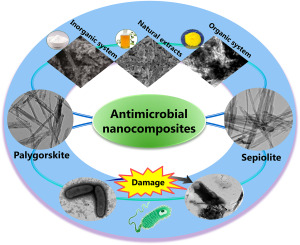Abstract
Sepiolite (Sep) and palygorskite (Pal) are naturally available one-dimensional (1D) clay minerals. Their special pore structures, affluent surface groups, high specific surface area and better ion-exchange capacity make them feasible for the construction of functional antimicrobial nanocomposite and hybrid materials. The silanol groups at the external surface of these 1D clay minerals and their surface electrical charge play crucial roles in the interactions with various antimicrobial agents, and the presence of structural cavities (tunnels and channels) allows small molecules to be immobilized inside them. The main functions gifted by Sep and Pal to the formed nanomaterials include improvement of dispersion behavior of loading agents, targeting release of the active compounds in a sustained manner, and enhancement of material stability. In addition, the characters of nontoxicity, biocompatibility, and eco-friendliness make the 1D clay minerals and their derived composites widely used in fields involving human health. In this review, various antimicrobial nanocomposite and hybrid materials developed through incorporation of Sep and Pal with myriad antimicrobial agents such as metal and metal oxide nanoparticles, metal ions, antibiotics, essential oils, surfactants, and biopolymers with improved physicochemical properties as well as enhanced antimicrobial activities were discussed. These antimicrobial nanocomposite and hybrid materials could be applicable in various fields such as food packaging, wound dressing, and feed additives for animal health, and will become promising innovative antimicrobial nanomaterials to inhibit pathogenic bacteria.

Keywords Plus:QUATERNARY PHOSPHONIUM SALTESSENTIAL OILSANTIBACTERIAL ACTIVITYESCHERICHIA-COLINANOMATERIALS STRUCTURENANOPARTICLESSILVERCOPPERFILMSCLAYS
Published in APPLIED CLAY SCIENCE,Volume219;10.1016/j.clay.2022.106454,MAR 1 2022


